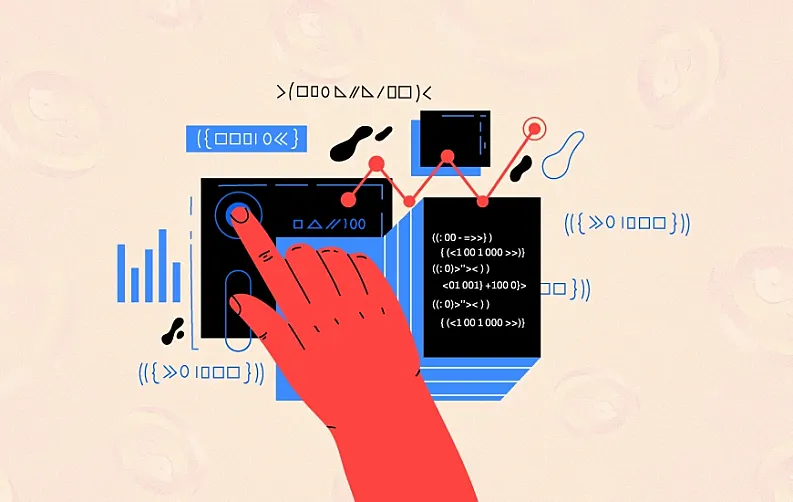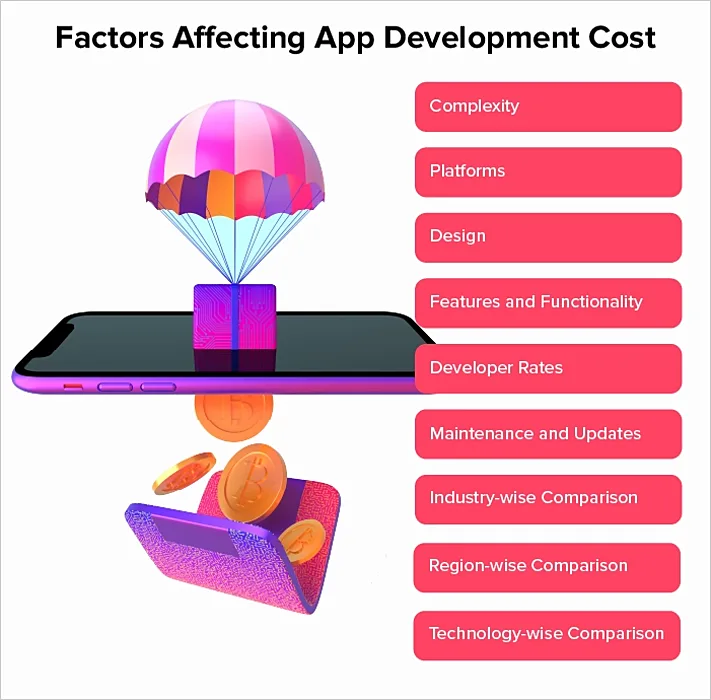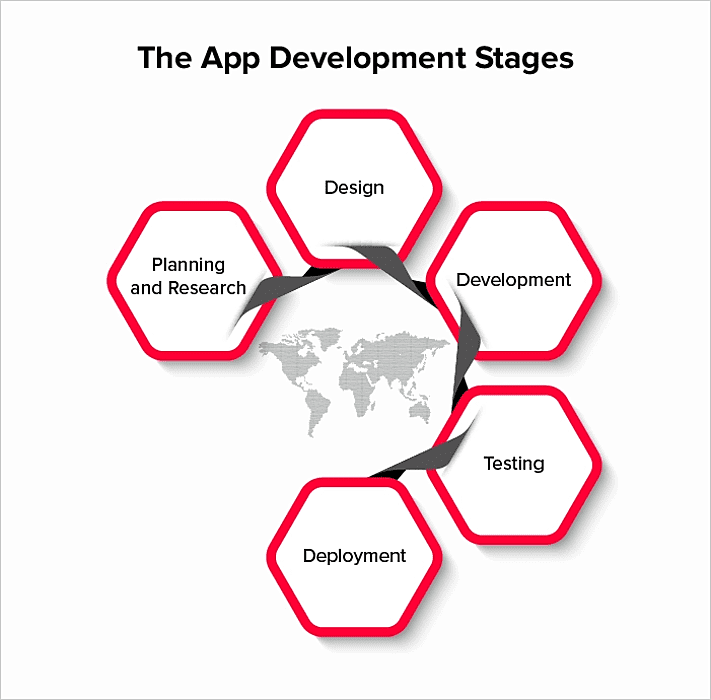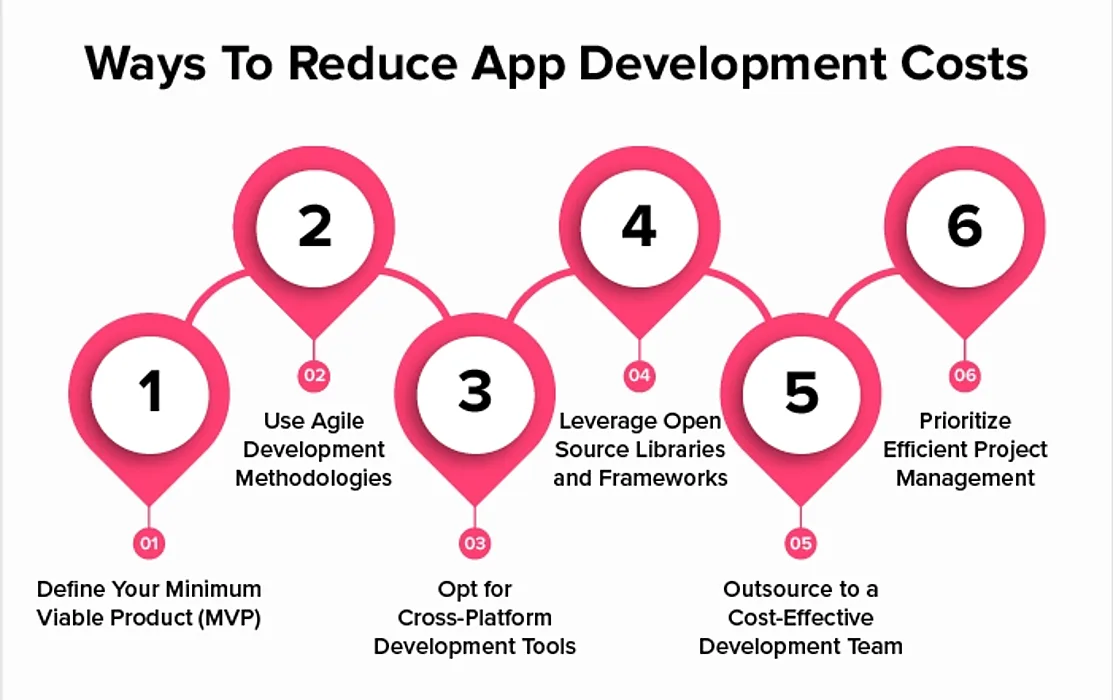
Developing an app can be very lucrative, but it requires some upfront costs. So, how much does it cost to develop an app? The size and complexity of the app being developed can have a significant impact on the development cost. While some apps may be developed for as cheap as $5,000, others can cost over $1 million!
Naturally, the cost of developing an app increases with its complexity and feature set. Before making any commitments, it's a good idea to figure out the project's budget and schedule as you start to plan the development of your app. If you do this, you'll reach your goals and make wiser financial judgments.
This article will describe the typical cost to maintain an app incurred in creating an app, from the beginning to publishing it online or through the App Store. We'll also review the different elements that go into the total cost of app development and offer some advice on staying within budget while still producing a quality app.
Factors That Determine Cost To Develop An App
In 2024, several important aspects will be taken into account while developing a mobile app, which will have a substantial impact on the final cost to develop an app. Comprehending these components can aid top mobile app development companies in making well-informed choices and allocate sufficient funds for their app development endeavors.
Below, we explore the main elements that affect app development costs, providing a thorough analysis and
relevant examples.
1. Complexity
| Complexity Level | Feature Examples |
| Simple | Basic UI components, no API integration, standard platform features |
| Medium | Custom UI/UX design, payment integration, API integration |
| Complex | Advanced functionalities (AI, ML), custom animations, complex backend |
One of the main factors influencing an app's development cost is its complexity. It is usually classified as simple, medium, or complex depending on its features and functionalities.
2. Platforms
| Platform Type | Description |
| ios | Developed specifically for Apple devices; it tends to have a higher user engagement |
| Android | Targets a wider audience, especially in emerging markets |
| Hybrid | Cross-platform apps that can run on both iOS and Android from a single codebase |
| Web Apps | Accessible via web browsers and not installed on the device |
Selecting the appropriate platform (iOS, Android, Hybrid, Web Apps) for your project greatly impact cost to develop an app.
3. Design
When we make an app, we focus on how it looks and how easy it is to use. This happens when we design it. This design part is super important because it affects how happy users are, how much they use the app, and if the app becomes popular. A well-designed app is not just pretty to look at, but also easy to figure out and use. This makes people want to spend more time on the app and use all its cool stuff.
Custom Design vs. Template-Based Design: Choosing a custom design implies that the app's objectives and brand identity are all considered while understanding the role of UI/UX. In a busy market, an app can really catch people's attention by using a special method to come up with unique and creative design ideas.
User Engagement and Retention: An app's appearance significantly impacts the app engagement and user retention. Making the app easy to use and look nice can make customers happier. When people like the app, they tell others about it and give it good ratings, which keeps existing customers around and brings in new ones.
Brand Identity and Consistency: Brand components like colors, logos, and typefaces can be incorporated into a custom design to ensure consistency across all user touchpoints. This consistency helps consumers trust and remain loyal to the app while also reinforcing brand strategies for startups.
Addressing User Needs and Preferences: Custom designs are made to fit exactly what the people using them want and like. Designers figure this out by studying and testing what works best for the specific group of people using the app. Then, they put these good things into the design to make using the app feel just right for those people.
Overcoming Design Limitations: Sometimes, templates that are already made might not fit well with all the special things you want in your app or how you want to organize stuff. This could make it harder for people using your app to get what they need. Making your own designs is better because they can fit perfectly with what your app needs and how people will use it.
Future Scalability: Custom designs are usually easier to change and adjust. This means it's simpler to add new stuff or tweak how the app works based on what users want or how things are going in the industry. As time passes, how well the app can keep up and stay useful might rely on how easily it can change.
4. Features and Functionality
One important aspect that can significantly increase the cost to develop an app is the incorporation of sophisticated features and functionality. Developers are pressured to include advanced technologies to enhance app performance and user experience. This demand arises as the market for complex, user-focused apps grows. Here's a closer look at how these characteristics affect development:
Geolocation Services: Geolocation apps give you personalized stuff based on where you are, like telling you the weather nearby, helping you find your way around, suggesting things to do nearby, and more. To do this, they need to constantly handle your location data quickly and accurately, which can be tough while also trying to save your phone's battery.
AI Integration: Apps can be made smarter and more user-responsive by incorporating artificial intelligence (AI). Using AI in different systems needs a lot of work to handle data and train algorithms. It doesn't matter if it's for things like automatic customer service, smart assistants, text predictions, or personalized content. Doing all this takes more time and money because you have to train the algorithms and process lots of data. It requires people who know about machine learning and understand human language really well.
Sophisticated Data Processing: Resilient backend infrastructures are crucial for complex data processing apps, like financial analysis tools or health monitoring systems. The same goes for customer relationship management (CRM) softwares. Setting up safe computer systems to keep information secret, store it safely, and get it back when needed is important. When dealing with lots of information, making sure it's secure can make things more complicated. Sometimes, you have to find a good balance between keeping things safe and making sure everything runs smoothly and fast.
Third-Party Integrations and Custom APIs: When you add other services or special features to an app, it can do more things like talk to different devices, databases, or other social media apps. This helps the app work better with different systems like the Internet of Things (IoT). For example, it could let you share stuff on social media, handle payments, or connect to smart gadgets. But, it also makes it trickier to ensure everything stays safe, works well together, and gives users a good experience.
Real-time Features: Ensuring messages, live updates, and streaming work smoothly on a server requires a lot of work with the development of IoS application. It involves using certain technologies and rules to ensure data moves quickly and reliably. If many people use the app at once, even more effort might be needed to keep things running smoothly.
Security Measures: It's important to have really strong security because fancy features often deal with private user information. Things like coding stuff so it's scrambled, making sure only the right people can get in, and following laws about keeping data safe, like GDPR or HIPAA, are crucial. But doing all this can make building things harder and cost them more.
User Interface and Experience Enhancements: We need to improve our product without making it harder for users to use. Making a cool and easy-to-use design might take more work to make sure it works well for people. We might need to try different versions until we get it just right.
5. Developer Rates
| Location | Freelancer Rate | Agency Rate |
| USA | $100-$150/hr | $150-$250/hr |
| India | $20-$40/hr | $30-$80/hr |
| UK | $70-$100/hr | $100-$200/hr |
| Canada | $75-$125/hr | $125-$225/hr |
| Poland | $40-$60/hr | $50-$100/hr |
Location, whether you're hiring through an agency or independent contractors, and the expertise level of the developers all affect the cost to develop an app.
6. Maintenance and Updates
Once an app is released, regular updates and fixes are needed to stay competitive. This means solving any issues, updating to the latest system version, and adding new features that users ask for. These tasks usually take up around 15% to 20% of the yearly budget for developing the app. It's a big part of the money spent on making the app in the first place.
7. Industry-wise Comparison
| Industry | Requirement | Average Development Cost |
| Healthcare | HIPAA compliance, secure data handling | $50,000 - $100,000 |
| Fintech | Robust security, banking API integration | $60,000 - $120,000 |
| E-commerce | Payment processing, inventory management | $40,000 - $100,000 |
| Educational | Interactive content, database integration | $30,000 - $70,000 |
| Entertainment and Gaming | High-quality graphics, cross-platform support | $50,000 - $200,000+ |
| Real Estate | Mapping, virtual tours, CRM integration | $40,000 - $80,000 |
| Transportation and Logistics | Real-time tracking, route optimization | $50,000 - $100,000 |
App development costs vary widely across different industries due to specific requirements, regulations, and functionalities. The table below shows how much it typically costs to make different kinds of apps. It also explains how the specific needs of each industry can change these costs.
8. Region-wise Comparison
The cost of labor, market demands, and the availability of competent developers cause development costs to range greatly between areas.
| Region | Average Cost Range |
| USA | $100,000 - $500,000+ |
| India | $20,000 - $80,000 |
| UK | $75,000 - $300,000 |
| Canada | $80,000 - $350,000 |
| Poland | $40,000 - $120,000 |
9. Technology-wise Comparison
Choosing which technologies to use can affect how much it costs to make an app. If you use native solutions, you'll need to write separate code for iOS and Android app development, which can be expensive. But if you use cross-platform solutions, you can write just one set of code that works on both, saving money. Web technologies are cheaper too, but they might not work as smoothly as native apps.
Hidden Costs to Consider
When making a budget for creating an app, it's really important to remember to include all the costs, not just the obvious ones like designing and developing the app. You also need to think about the less obvious costs that can pop up along the way. These can greatly impact the total cost to develop app. To ensure proper planning and prevent fuure financial surprises, it is imperative to comprehend these hidden costs.
1. App Store/Marketplace Fees
Publishing an app on Google Play or Apple's App Store costs money that some developers might not realize. Google Play charges $25 one time, while the App Store charges $99 every year. Also, when people buy things in the app or subscribe to it, the store takes a cut, usually between 15% and 30%, which means the developer gets less money.
2. Backend Infrastructure and Data Storage
The main part of an app is its backend setup and where it stores information. This is what lets the app do things like show content, check if users are who they say they are, and keep data up-to-date across different devices. Cloud computing services, database administration, and server hosting are all recurring average cost to develop an app for these components. These costs can vary a lot. Some apps might only cost a few dollars each month, while others, especially ones with lots of users, might cost thousands of dollars. It all depends on how complex the app is and how much information it handles.
3. Marketing and Launch
Making great software is only part of the challenge; the other part is getting people to use it. Especially for apps entering really competitive areas, the money spent on advertising and launching them can often be more than what was spent on actually making them. Setting aside money for influencer collaborations, social media advertising, app store optimization (ASO), and promotional events is essential to ensuring the app is following the mobile app launch checklist.
4. Third-Party Integrations
Many apps need extra help to do things like sending pop-up messages, tracking data, handling payments, and connecting to social media. They get this help from other companies’ services. These services make the app better, but they often charge based on how much they're used or with a regular fee. Popular payment gateways, for instance, usually impose a custom app development cost, while analytics services could require a monthly membership. These costs may increase, particularly as the program grows in size and usage.
Average App Development Cost Breakdown by Development Phase
Several steps are involved in developing an app, and each one affects how successful and ready the finished product is for the market. The app's complexity, the platforms it is intended for, and the development team's location can all have a big impact on the average app development cost.
The average cost of an application can range from $10,000 for simple apps to over $250,000 for big ones with plenty of features. A summary of the typical expenses related to each stage of development may be seen below:
| Development Phase | Average Cost Range |
| Planning and Research | $1,000 - $5,000 |
| Design | $5,000 - $20,000 |
| Development | $10,000 - $200,000+ |
| Testing | $5,000 - $15,000 |
| Deployment | $500 - $3,000 |
1. Planning and Research
The process of developing an app begins with careful planning and research, which establishes the foundation for every mobile app development companies in UK. This first stage is crucial for determining the app's goal, figuring out who the intended user base is, and gauging the app's potential. Goal-setting, competitive analysis, and market analysis are examples of activities. The cost to create an app, which usually ranges from $1,000 to $5,000, includes market research instruments, rough design sketches, and consultations. It's an essential investment to match the app's goals with user expectations and market demands.
2. Design
After laying the foundation, the design step turns this idea into a functional user interface (UI) and user experience (UX) cost. Creating wireframes, prototypes, and the app's final design specs are all included in this step. The custom business app development cost for this stage is $5,000 to $20,000. It reflects the intricacy of the design of the application, the number of screens, and the distinctiveness of the UX/UI components. A well-done design process guarantees the application is aesthetically pleasing, simple to use, and intuitive.
3. Development
The app takes shape during the development phase when programmers code the features, integrate databases, and place the required API development practices. This phase requires the greatest resources; depending on the app's complexity, the technology being used, and whether it is being built for several platforms, the cost to create an app can range from $10,000 to over $200,000. During this phase, we're doing both the design of what users see (like buttons and menus) and the coding that makes the website or app actually work behind the scenes. The price can change a lot depending on what fancy stuff we're adding, from just showing basic info to doing complex things like updating data in real time and connecting with other online services.
4. Testing
Testing makes sure the app works well, stays safe, and can work on different devices and systems. There are different tests like checking individual parts, how they work together, and if users find it easy to use. Testing usually costs between $5,000 and $15,000, depending on how complicated the app is and how much testing it needs. Spending money on thorough testing means users won't run into problems, which is super important for the app to do well once it's out there.
As per the Systems Sciences Institute at IBM,
“the cost to fix an error found after product release was 4 to 5 times more than one uncovered during design, and up to 100 times more than one identified in the maintenance phase”.
In 2017, another research by Tricentis based on 606 software bugs from 314 companies stated that software bugs caused economic damage of $1.7 trillion in losses. It impacted almost the world’s half of the population.
5. Deployment
Deployment is like the final step in making an app. It's when you start telling people about it and putting it up for download in app stores. This phase in the cost to create an app, which ranges from $500 to $3,000, covers app store fees and the first advertising campaign to promote the app's release. Effective launch marketing tips can have a substantial impact on the app's early user adoption rates, even though deployment expenses are generally lower than those of other stages.
How To Reduce App Development Costs?
Although it may seem difficult, lowering app development expenses without sacrificing quality with careful planning and astute decision-making is possible. Here are a few practical strategies for managing the cost to build an app:
1. Define Your Minimum Viable Product (MVP)
To begin with, determine what essential features your program needs to fulfill its main goal, and please beta testers. Using Minimum Viable Product (MVP) development, you can release your software with the basic features, cutting down on the time and cost to make an app. Additionally, it offers a chance to get customer input for upcoming improvements and additions, ensuring that you spend money on products that people actually want.
2. Use Agile Development Methodologies
Agile development breaks down the project into smaller parts and tackles them in short bursts called iterations or sprints. This approach lowers the possibility of expensive revisions or overhauls at the end of the development phase for mobile app development companies in Canada. It means you can change things more easily based on feedback. Also, it helps to be more accurate with how you use money and plan your budget so you can control spending better.
3. Opt for Cross-Platform Development Tools
Think about using React Native or Flutter instead of making separate apps for iPhones and Android phones. These tools help you save a lot of time and money because you can write the code for your app once and then use it on both types of devices. Plus, your app will still work great on iPhones and Androids.
4. Leverage Open Source Libraries and Frameworks
A wide ecosystem of free and open-source libraries and frameworks is available to expedite development and cut the cost to build an app. These mobile app development frameworks offer ready-made parts and features that you can easily add to your app. They help you avoid starting completely from scratch when you want to include common features.
5. Outsource to a Cost-Effective Development Team
Depending on where your development team is located, the cost to develop an app can vary significantly. You can hire skilled developers from countries where labor costs are lower, which saves you money compared to hiring in pricier places. Just make sure they meet your standards for quality and communication.
6. Prioritize Efficient Project Management
Reducing the cost to build an app requires effective project management. It means keeping in touch with each other, finishing tasks on time, and sticking to the plan for the project. We also need to avoid adding extra stuff to the project that wasn't part of the original plan because it can make things take longer and cost more.
The Most Popular Global Apps and Their Development Cost
Here are some examples of widely used applications that are leaders in the app market and have greatly impacted user experiences. We've also given an estimate of the cost of app development for Netflix and other applications.
1. Uber
Uber is a ride-sharing pioneer that has revolutionized urban mobility by seamlessly connecting drivers and riders through its smartphone. Users can make instantaneous or prearranged ride requests, and requests from nearby drivers are fulfilled. The cost to develop an app like Uber usually ranges from $30,000 to $100,000, depending on features like driver/rider interfaces, real-time tracking, and payment integration.
2. Tinder
With its user-friendly swipe-based matching system, Tinder has completely changed the dating scene. Users can decide whether or not to like another profile by looking at its pictures and short bio. The cost to develop an app like Tinder can cost anything from $40,000 to $100,000 with features like geolocation, a swiping mechanism, and in-app messaging.
3. Dropbox
Dropbox is a prominent cloud storage system that facilitates file syncing, sharing, and storing across numerous devices. The cost to develop an app like Dropbox can range from $50,000 to $100,000 for a comparable cloud-based service that offers file encryption, automatic backup, and simple sharing options.
4. TikTok
With its platform for making and sharing short films, TikTok has become a cultural phenomenon. To improve videos, it offers a wide range of filters and effects. The cost to develop an app like TikTok, can vary from $60,000 to $100,000 for a single platform, while hybrid development may cost up to $150,000.
Wrapping Up
Even in 2024, different things will still affect how much it cost of app development. It might be as simple as making a basic version of the app or as complicated as making one that works on lots of different devices. However, the cost can vary, ranging from $10,000 to more than $250,000. This variation highlights the importance of planning for mobile app development companies in the USA.
In conclusion, even if the app development field is always changing due to new technology and customer expectations, strategically developing an app can help control expenses. Mobile app development companies in India can control the cost of app development and ensure their app stays competitive by first focusing on important features, picking the right way to develop the app, and continuously improving it based on what users say.
In the end, an app's success depends not only on the amount of money invested in its creation but also on how well those funds are managed to produce a long-lasting and appealing product.



















